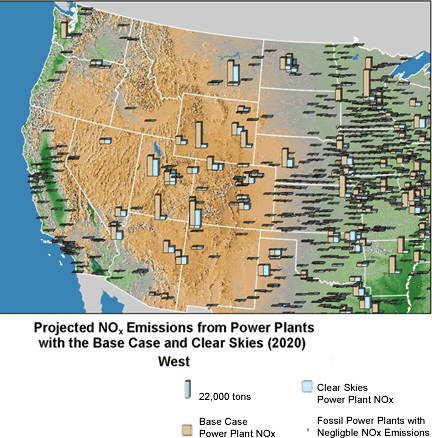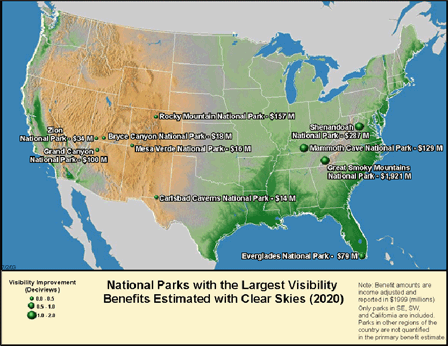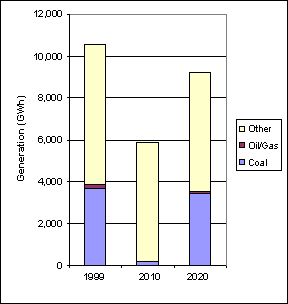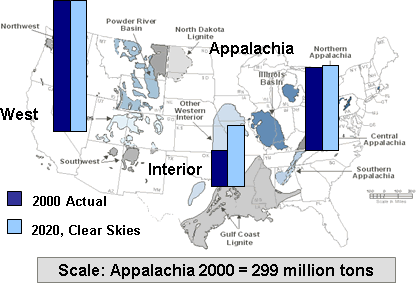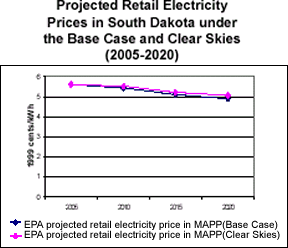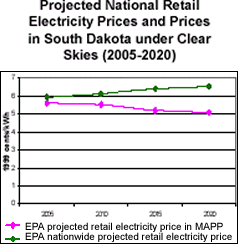Clear Skies
Clear Skies in South Dakota
Highlights of Clear Skies in South Dakota

- South Dakota sources would reduce emissions of NOx by 94% by
2020 due to Clear Skies; SO2 and mercury emissions remain unchanged.
- The health benefits in the West would total $8.6 billion annually
($1.6 billion under the alternative estimate) and include approximately
1,100 fewer premature deaths (600 under the alternative estimate)
and 2,500 fewer hospitalizations/emergency room visits each year.
Note: For the purposes of this analysis, the West includes all states that would be affected by the Zone 2 cap for NOx. These states are WA, OR, CA, UT, AZ, ID, MT, WY, CO, NM, TX, OK, KS, NE, ND, and SD.
- In addition, Western states would continue to enjoy good air
quality and visibility even in the face of increasing demand for
electricity.
- Clear Skies does not significantly impact electricity prices. With or without Clear Skies, electricity prices in the electricity supply region that includes South Dakota are expected to remain below 2000 prices.
Clear Skies: An Innovative Approach to Improving Human Health and the Environment
Why Clear Skies?
- Air quality has improved, but serious concerns persist.
- South Dakota's citizens suffer ill effects from air pollution, including asthma attacks and premature death
- Electricity generation sector remains a major emissions source
- Very cost-effective to control the power sector, relative to other sources
- Sources are concerned about upcoming complex and burdensome regulations
Advantages of the Clear Skies Approach
- Guarantees significant nationwide emissions reductions -- beginning
years before full implementation
- South Dakota sources would reduce or hold the line on emissions
of SO2, NOx, and mercury
- Delivers dramatic progress towards achievement of critical health and environmental goals
- South Dakota sources would reduce or hold the line on emissions
of SO2, NOx, and mercury
- Uses proven, market-based flexible approach with incentives
for innovation
- Recognizes environmental needs as well as industry constraints, allowing industry to better manage its operations and finances while lowering risks to the public
- Sources are projected to install pollution controls to enable continued reliance on coal
- Increases certainty across the board for industry, regulators, and consumer
Under Current Clean Air Act Power Plants Would Face a Complex Set of Requirements
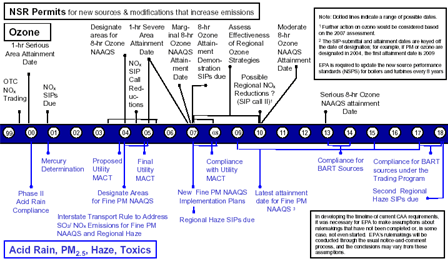
For a larger image, click here.
Clear Skies Sets a Firm Timeline for Emission Reductions
| The existing Title IV SO2 cap-and-trade program provides an incentive and a mechanism to begin reductions upon enactment of Clear Skies years before regulatory action under the current Act. |
2004: The NOx SIP call (summertime NOx cap in 19 Eastern States + D.C.)
2008: Clear Skies NOx Phase I (2.1 million ton annual cap assigned to two Zones with trading programs)
2010:
- Clear Skies Hg Phase I (26 ton annual cap with a national trading program)
- SO2 Phase I (4.5 million ton annual cap with a national trading
program)
2018:
- Clear Skies NOx Phase II (1.7 million ton annual cap assigned to two Zones with trading programs)
- Clear Skies Hg Phase II (15 ton annual cap with a national trading program)
- Clear Skies SO2 Phase II (3.0 million ton annual cap with a national trading program)
Clear Skies Builds Upon the Work of the WRAP
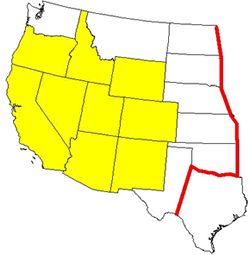 Note: Yellow states are states involved in the WRAP voluntary emissions reduction program. |
- Clear Skies is designed to support the WRAP goals and process;
in addition to a national constraint on SO2, the bill ensures
that the WRAP's emissions reduction goal for nine states is achieved:
- If for any reason the regional reduction goal set by the WRAP for 2018 (271,000 tons for the power sector) is not achieved, a separate WRAP cap-and-trade program is triggered to ensure that the regional reductions are preserved.
- This special cap-and-trade program is based on the framework established in the WRAP process.
- This special cap can also be triggered by 2013 if States determine there is sufficient evidence that the target will not be met by 2018.
The West Faces Unique Challenges
- Environmental effects of power plant emissions - including visibility impairment and acid deposition - are broadly distributed
- Increasing ground-level ozone concentrations in national parks
- Particle-related haze in national parks and wilderness areas
- Nitrogen deposition in high elevation ecosystems (e.g., Colorado Front Range)
- Brown clouds in major cities
- Few western non-attainment
areas are due to stationary
source emissions
As the West Grows, Clear Skies Protects Human Health and the Environment
 The
West Will Continue to Grow...
The
West Will Continue to Grow...
- Population is projected to grow more than 20% from current levels by 2020
- Electricity demand is expected to grow more than the national
average
- More than 10% over national average in the Pacific States
- More than 30% over national average in the Mountain States
 ...While
the Environment Is Protected
...While
the Environment Is Protected
- Clear Skies would protect air quality by lowering or halting
increases in air emissions throughout the West from today's levels:
- Prevent degradation of visibility in parks.
- Help counties remain in attainment with health-based air quality standards, reducing the burden on state and local governments.
- Ensure nitrogen deposition does not increase and reduce mercury deposition
Emissions in South Dakota under Clear Skies
Emissions in South Dakota (2020) would be significantly reduced
from 2000 levels:
|
Emissions: Current (2000) and Existing Clean Air Act Regulations (base case*) vs. Clear Skies in South Dakota in 2010 and 2020
Sulfur dioxide
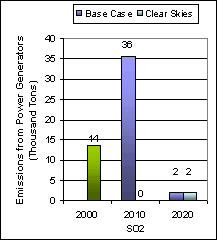
Nitrogen oxides
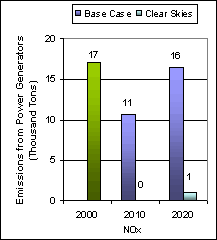
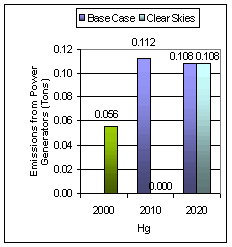
SO2 and NOx Emissions Reductions under Clear Skies
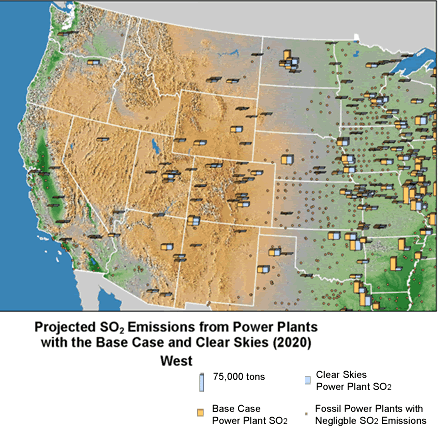
Note: Retrofits and total
coal-fired capacity apply to coal units greater than 25 MW.
Electricity Prices in South Dakota under Clear Skies
|
|
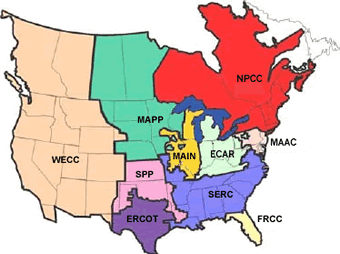
|
Note: The base case using IPM includes Title IV, the NOx SIP Call, NSR settlements, and state-specific caps in CT, MA, MO, NC, NH, TX, and WI. It does not include mercury MACT in 2007 or any other potential future regulations to implement the current air quality standards or other parts of the Clean Air Act. Base case emissions in 2020 will likely be lower due to state and federal regulatory actions that have not yet been promulgated. Costs and Benefits in South Dakota under Clear SkiesBenefits Outweigh the Costs
Note: Costs include capital costs, fuel, and other operation and maintenance costs (both fixed and variable) associated with the achievement of the emissions caps in the legislation (for example, the installation and operation of pollution controls). These state-level production costs are estimates; they do not account for the costs associated with the transfer of electricity across regions, nor the costs or savings that could be associated with allowance movement between sources. Notes on EPA's Analysis
1.An alternative methodology for calculating health-related benefits projects approximately 600 premature deaths prevented and $1.6 billion in health benefits each year in the West by 2020. 2. Based on 1999-2001 data for counties with monitors that have three years of complete data.
|
|||||||||||||||||||||||||


